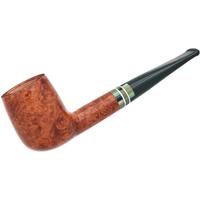Buffing/Polishing Compounds to Use with Buffing Machine?
- Thread starter Tabacco
- Start date
You are using an out of date browser. It may not display this or other websites correctly.
You should upgrade or use an alternative browser.
You should upgrade or use an alternative browser.
I can’t imagine where I would need to resort to fuming stems with acetic acid, but that’s an interesting method to keep in mind. Folks, do heed the warning about fumes with acetic acid especially glacial acetic acid. I personally wear a respirator with acid gas combo cartridges, good eye protection and gloves when working with the stuff, even if outdoors. Also, if you have ever walked into a photographic darkroom and notice that familiar darkroom smell, it is due in large part to acetic acid used in stop bath. It just seems to get in the walls and stick, even years after no photographic work has been done in the room.
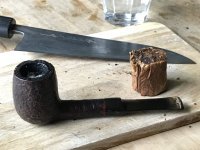
Cut a few slices off the Motzek curly Strang with my sharpened hocho. The scandia sandblasted billiard with ebonite saddle mouthpiece i bought on Milnerton flea market, Cape Town. It took a while to get the ghost out, fitted the loose tenon while heating it up in near boiling water and pressing it slightly on the table.
Acetic acid is not such a dangerous thing as a lot of other chemicals. And besides of the steam you’re handling still that diluted acid of max 60 percentage. Have you ever eaten a salad with some vinegar? Nevertheless you have to be careful because of the heat and yes the steam inhaling can cause some trouble, so don’t do that. The good thing is the solving of the sulfur is done in no time. All the other methods sanding down the mouthpiece ore putting it in oxy cleaner is far more time consuming.
I’ve been working in a darkroom for more than 30 years, the worst thing was the smell of fixing bath.
I’ve been working in a darkroom for more than 30 years, the worst thing was the smell of fixing bath.
I envy those with room for polishing wheels. There’s lot of exotic solutions on the market. The Briarworks product is very good, and the pen guy makes a good solution. I’m still with oxy and water, then magic erasure, then the micro pads. There was some stem polish that worked for me a while back from Walkers but not made anymore. Then I lay on some good Carnuba wax and use a soft cloth.
Mineral oil can be used in place of obsidian oil in a pinch.
Mineral oil can be used in place of obsidian oil in a pinch.
I just priced--off hand--the kit I use for polishing: A Dremel rotary tool, polishing wheels, Tripoli Compound, White Diamond Compound and Canauba Wax. You can purchase all this stuff off Amazon for less than $100. (Of course there are other things I use: Alcohol, sand paper (lots of various grits). and the like.
should you clean the stems between Tripoli Compound, White Diamond Compound and Canauba Wax. as to not get the different buffing wheels with the other compounds? and what, how, would you clean them?
I use a Dremel with 1-inch polishing buffing wheels through Amazon from the company FPPO ($12.50). They produce a set of 50 different wheels. For the compound applications I only use the yellow and white cloth wheels. I use one-each yellow wheel for the Tripoli and White Diamond, and a white one for the Canauba wax. (I do not own a big buffing wheel.) The Dremel accessories change in-and-out very quickly. Any leftover compound gets wiped off the stem before I switch compounds. I apply the wax using the heat friction from the white cloth wheel and really flash it on thick. I then polish off the excess as best I can with a rag, and then switch back to the Dremel with a cashmere polishing ball until all overt evidence of the wax is gone. The final step is a quick hand polish with an old chambray work shirt.should you clean the stems between Tripoli Compound, White Diamond Compound and Canauba Wax. as to not get the different buffing wheels with the other compounds? and what, how, would you clean them?
When it comes to the stems, the Tripoli will pretty much do the trick if the stem is clean. I don't normally use the White Diamond on a stem. I will connect the stummel and stem for the waxing.
(To clean a stem I use AWESOME! cleaner full-strength with a toothbrush. For a really bad stem with lots of oxidation, I will use 600-grit wet/dry sandpaper and graduate up to 1000 or so with plenty of water and cleanser. Often I will then resort to alcohol (Everclear) and sandpaper (1000-to-3000 whatever I happen to have.) The Tripoli will not remove obvious scratches, so those have to be sanded out. Once the stem is clean of most of the oxidation, and looks flat and drab it will polish to a gleam with Tripoli. )
Here's a picture. Used buffing wheels. (The red, green, and brown wheels help with removing old stain prior to rough sanding to bare wood on the stummel.) The compounds are top to bottom: Tripoli, White Diamond, and Carnauba wax. Notice how the polishing wheels dig in and distort the compound bars.
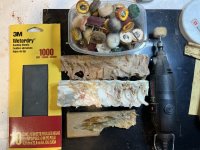
Anytime you use abrasives, you should clean thoroughly between grits.should you clean the stems between Tripoli Compound, White Diamond Compound and Canauba Wax. as to not get the different buffing wheels with the other compounds? and what, how, would you clean them?
I used isopropyl alcohol on a cloth for a wipe, as to not transfer between buffing pads.Anytime you use abrasives, you should clean thoroughly between grits.
And, rake the pads occasionally.
Thank you for all of the information. This really helpsI use a Dremel with 1-inch polishing buffing wheels through Amazon from the company FPPO ($12.50). They produce a set of 50 different wheels. For the compound applications I only use the yellow and white cloth wheels. I use one-each yellow wheel for the Tripoli and White Diamond, and a white one for the Canauba wax. (I do not own a big buffing wheel.) The Dremel accessories change in-and-out very quickly. Any leftover compound gets wiped off the stem before I switch compounds. I apply the wax using the heat friction from the white cloth wheel and really flash it on thick. I then polish off the excess as best I can with a rag, and then switch back to the Dremel with a cashmere polishing ball until all overt evidence of the wax is gone. The final step is a quick hand polish with an old chambray work shirt.
When it comes to the stems, the Tripoli will pretty much do the trick if the stem is clean. I don't normally use the White Diamond on a stem. I will connect the stummel and stem for the waxing.
(To clean a stem I use AWESOME! cleaner full-strength with a toothbrush. For a really bad stem with lots of oxidation, I will use 600-grit wet/dry sandpaper and graduate up to 1000 or so with plenty of water and cleanser. Often I will then resort to alcohol (Everclear) and sandpaper (1000-to-3000 whatever I happen to have.) The Tripoli will not remove obvious scratches, so those have to be sanded out. Once the stem is clean of most of the oxidation, and looks flat and drab it will polish to a gleam with Tripoli. )
Here's a picture. Used buffing wheels. (The red, green, and brown wheels help with removing old stain prior to rough sanding to bare wood on the stummel.) The compounds are top to bottom: Tripoli, White Diamond, and Carnauba wax. Notice how the polishing wheels dig in and distort the compound bars.
View attachment 180340
Great set up @MilesDavis. Incidentally I sent a PM with a question.I use a Dremel with 1-inch polishing buffing wheels through Amazon from the company FPPO ($12.50). They produce a set of 50 different wheels. For the compound applications I only use the yellow and white cloth wheels. I use one-each yellow wheel for the Tripoli and White Diamond, and a white one for the Canauba wax. (I do not own a big buffing wheel.) The Dremel accessories change in-and-out very quickly. Any leftover compound gets wiped off the stem before I switch compounds. I apply the wax using the heat friction from the white cloth wheel and really flash it on thick. I then polish off the excess as best I can with a rag, and then switch back to the Dremel with a cashmere polishing ball until all overt evidence of the wax is gone. The final step is a quick hand polish with an old chambray work shirt.
When it comes to the stems, the Tripoli will pretty much do the trick if the stem is clean. I don't normally use the White Diamond on a stem. I will connect the stummel and stem for the waxing.
(To clean a stem I use AWESOME! cleaner full-strength with a toothbrush. For a really bad stem with lots of oxidation, I will use 600-grit wet/dry sandpaper and graduate up to 1000 or so with plenty of water and cleanser. Often I will then resort to alcohol (Everclear) and sandpaper (1000-to-3000 whatever I happen to have.) The Tripoli will not remove obvious scratches, so those have to be sanded out. Once the stem is clean of most of the oxidation, and looks flat and drab it will polish to a gleam with Tripoli. )
Here's a picture. Used buffing wheels. (The red, green, and brown wheels help with removing old stain prior to rough sanding to bare wood on the stummel.) The compounds are top to bottom: Tripoli, White Diamond, and Carnauba wax. Notice how the polishing wheels dig in and distort the compound bars.
View attachment 180340
Lots of good ideas. Let me put forth what I do in my refurbishing. After trying OxiClean; Before ‘n After I came across Briarville’s water based deoxidizer. I have probably done about 75 pipes with this stuff. After washing the deoxidizer off micromesh pads (series of 9) with obsidian oil in between each pad. Then fine and extra fine polish from bel epoque pens. It’s pretty low tech but nowhere in the process can you ruin a stemGreat set up @MilesDavis. Incidentally I sent a PM with a question.
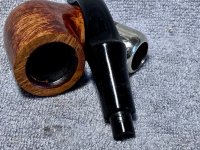
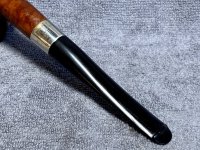
This was definitely a good advice. I mounted a backstop with a thick foam pad. I think I will add a couple of neoprene sheets under the two wheels as well.
Thank you!
View attachment 162193
I know this is an old post, but I'm curious as to how well your mini bench polisher is holding up.I use microfiber cloths (post # 15) but I think that just kitchen paper would work for the stems.
A buffer is for buffing. If stems are like old estates with heavy oxidation you will need to do more than a buffer will do. If you were to have enough abrasive ability in a buffer to remove that depth of oxidation you would likely ruin the stem. Maybe the uber pro guys can do it...I dont know. I know I have a fair amount of experience at a buffing wheel and its really for your final work. Hard labor is what is required for really green or brown stems.





